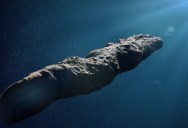Project Lyra Aims To Use Solar Gravity To Catch The Interstellar Asteroid Named ʻOumuamua

Do you remember the late 90’s disaster flick Armageddon? It’s surprisingly entertaining, but I don’t think most of us figured the plot would be resurrected by actual scientists some day.
That said, it sure sounds like the people who came up with Project Lyra might have seen it a time or two and come away with inspiration in the back of their minds.
In 2017, astronomers at the Pan-STARRS observatory spotted a fast-moving (85,700 miles per hour) asteroid hurtling past the sun. Some more calculations had scientists estimating the object was around 1300 feet long and shaped sort of like a pancake.
They dubbed the object A/2017U1, or ‘Oumuamua, did not come from our Solar System and likely won’t stay forever, either. Researchers love the idea of catching up with ‘Oumuamua, first and foremost to verify that it’s a natural object and not some kind of interstellar probe.
The reason for this question is that the object is accelerating at a rate that scientists are struggling to be able to explain.
Project Lyra explores the possibility of sending a spacecraft to chase 'Oumuamua using an Earth gravity assist to reach Jupiter, which robs the craft of almost all its speed, causing it to drop to the Sun for an Oberth maneuver.
Thanks @hibberdadam994 for the trajectory data! pic.twitter.com/1GmMKonlQV
— Tony Dunn (@tony873004) December 8, 2023
Catching it would be no easy feat – in fact, it remains nothing but a bunch of theories – but some think we could use a “Solar Oberth” maneuver to do just that.
It’s essentially using the Sun’s gravity to gain velocity for our own ship.
Deep space missions require gravity assists to gain and lose speed, conserving fuel in the process.
“Several robotic spacecraft have used the ‘gravity assist’ technique to achieve their targets ‘high up’ in the Sun’s gravity well. Voyager 2 launched in August 1977 and flew by Jupiter for reconnaissance, and for a trajectory boost to Saturn.”
It’s working well for NASA, but it’s always a tricky endeavor.
“Voyager 1 launched the following month and did the same (reaching Jupiter before Voyager 2 did). Voyager 2 then obtained an assist from Saturn and another one later from Uranus, climbing all the way to Neptune and beyond. Galileo took one kick from Venus and two from Earth, while orbiting the Sun en route to its destination, Jupiter. Cassini took two boost from Venus, one from Earth, and another from Jupiter to gain enough momentum to reach Saturn.”
The Oberth maneuver is named for Hermann Oberth, the man who first suggested it in 1928.
A popular animation showing Project Lyra with a Solar Oberth of 10 Solar Radii (SR) away from the Sun's centre. pic.twitter.com/Ha38eAm4El
— Adam Hibberd (@hibberdadam994) December 30, 2023
To complete one, you let a spacecraft drop into an object’s gravity well before using propellant to escape it.
In this case, the craft would also have to be protected from solar radiation.
Others have suggested this isn’t necessary, and that the craft could use Jupiter’s gravity to catch up with the object.
Even with all of this talk about super fast objects, it will take until 2050 – at the earliest – for any chance at finding out what this thing is.
So file it away for later.
If you thought that was interesting, you might like to read about a second giant hole has opened up on the sun’s surface. Here’s what it means.

Sign up to get our BEST stories of the week straight to your inbox.




